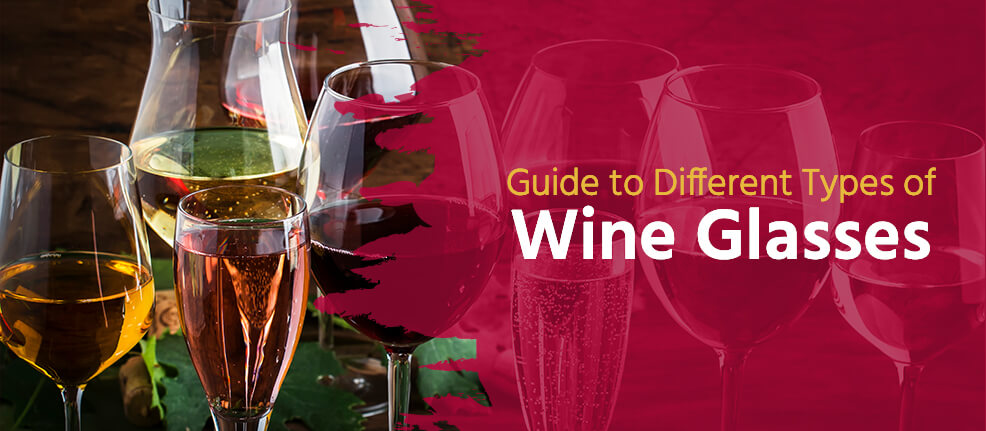
According to the Court of Master Sommeliers — the world’s most elite group of veteran wine experts for 50 years — there are nearly two dozen types of wine glasses available for serving wine today.
That’s a lot of cabinet space dedicated to wine glasses! It’s little surprise if you’ve recently browsed the dishware section of a home goods store. There are wide glasses and short glasses, tall and slender glasses — even funny-shaped glasses with special curved rims.
What are the different types of wine glasses, and why do they come in different shapes and sizes? Plus, does it matter which kind you use to serve wine, anyway?
Keep reading to explore our complete guide to the kinds of wine glasses and their uses, as well as the various wine glass shapes and purposes.
Why Are Wine Glasses Shaped Differently?
Wine glasses’ shapes create the optimal tasting and olfactory conditions for specific types of wine.
Given the sheer diversity of red and white wines, this makes sense. A glass’ shape will allow aromas to escape while you sip, which is necessary to experience the true nature of the wine. Likewise, wine glass shapes will then determine where sips land on your tongue. Some slide straight to the tip of your tongue, while others hit the middle or roof of your mouth, therefore eliciting different flavor responses.
In short, there’s a science to glass shapes — all designed to give you the best-tasting beverage possible.
What Are the Benefits of Matching Wine Glass With Wine Type?
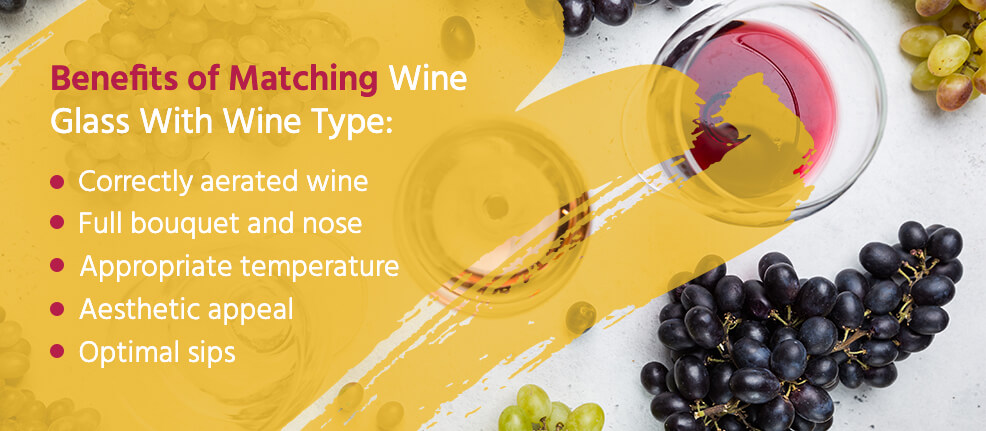
Matching the appropriate wine glasses with the types of wine you are serving ensures the best possible tasting experience for you and your guests. That’s because the design of glasses for red, white, rosé or sparkling wine each highlight the following.
- Correctly aerated wine: Certain types of wine — particularly tannin-heavy, bold reds like Barbera, cabernet sauvignon and others — need exposure to the air before serving. This aeration step allows the wine to “breathe,” literally oxidizing particular chemical compounds to unearth the full expression of its unique flavors. While it is best to aerate wines in a separate decanter, you can also use a large, varietal-correct wine glass as an aerating vehicle.
- Full bouquet and nose: As mentioned earlier, a proper white or red glass permits appropriate wine aromas to escape. This sense of smell is instrumental in tasting. Without these wafting aromas and bouquets, you won’t be able to savor a glass of wine’s authentic, fully developed flavors.
- Appropriate temperature: Every wine varietal has an ideal serving temperature. As your general rule, it’s best to serve white wines chilled or semi-chilled, between 49 and 55 degrees Fahrenheit. You’ll want to serve red wines at room temperature, between 62 and 68 degrees Fahrenheit. Depending on the stem type and shape, a drinker’s hand may envelop the entire glass, causing heat to transfer and raising its temperature above ideal serving conditions. This action, in turn, creates muddled or dulled flavors.
- Aesthetic appeal: Let’s be real — it’s fun to use pretty wine glasses. It’s even more fun to have a set of two to three types of wine glasses adorning your home bar cart or party drink station. Regardless of the situation, or what varietals of wine your friends bring over, you’ll have an attractive, yet functional, set ready to go.
- Optimal sips: When aeration, aroma, temperature and presentation come together, you’ll bring wine tasting to the next level.
The Anatomy of All Wine Glasses
There are four primary design characteristics associated with wine glasses.
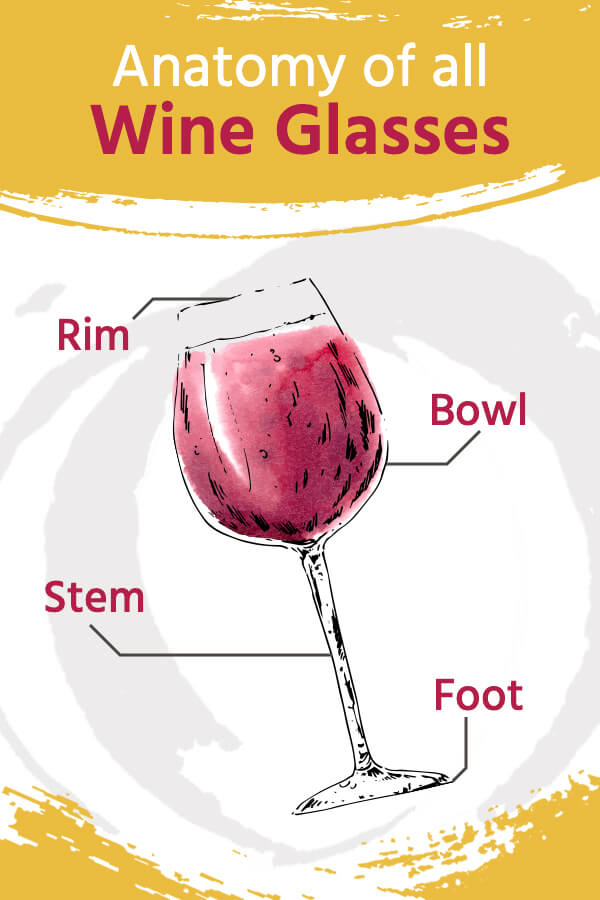
- The rim: Wine glass rims are the topmost section of the glass, or the part that comes into contact with your lips as you drink. For this reason, you’ll often hear the rim called the “mouth” of a glass. Thickness is the defining quality of wine rims. The thinner the rim, the easier and smoother wine sips.
- The bowl: Wine glass bowls are the basin portion you pour the wine into. The wider the bowl, the easier it is to swirl your wine between and before sips. Swirling your wine releases nuanced aromas that may hide in a static beverage, therefore unleashing a more complex taste. Generally, red wine glasses will have wider rims than most white wine glassware.
- The stem: Stems are the long, thin part of the glass drinkers hold without having to touch the bowl. Holding a glass by its stem preserves the wine’s serving temperature for the best possible tasting beverage.
- The foot: The foot of a wine glass is the circular base allowing the dishware to stand upright. The majority of wine glass types have this circular foot at the end of the stem. However, some, like the stemless tumbler, do not.
These four terms provide the basis for discussing different shapes of wine glasses. Together, the rim, bowl, stem and foot affect how a wine swirls and sips, as well as its temperature regulation and the aromas we smell while drinking. These four parts are fundamental to understanding the reason for wine glass shapes, as well as what kind of glass to pick when serving wine.
General Overview of the Different Types of Wine Glasses
Today, there are dozens of wine glassware available to show off at your next dinner party — or when savoring a glass by yourself. Let’s explore the top wine glass types below, each with distinct design elements coaxing the best from this drink.
1. Bordeaux Glass
The Bordeaux wine glass is the perfect foundation to begin profiling the world of wine glassware. Proportionate, but taller than any other glass on our list, Bordeaux glasses have a comparatively longer stem and leaner, thinner bowl. The smaller, but longer, bowl lets wine travel directly to the back of your tongue. This shape is ideal for rich, full-bodied and mouth-coating red wines, which may taste too sharp if they coat your entire tongue at once.
2. Burgundy Glass
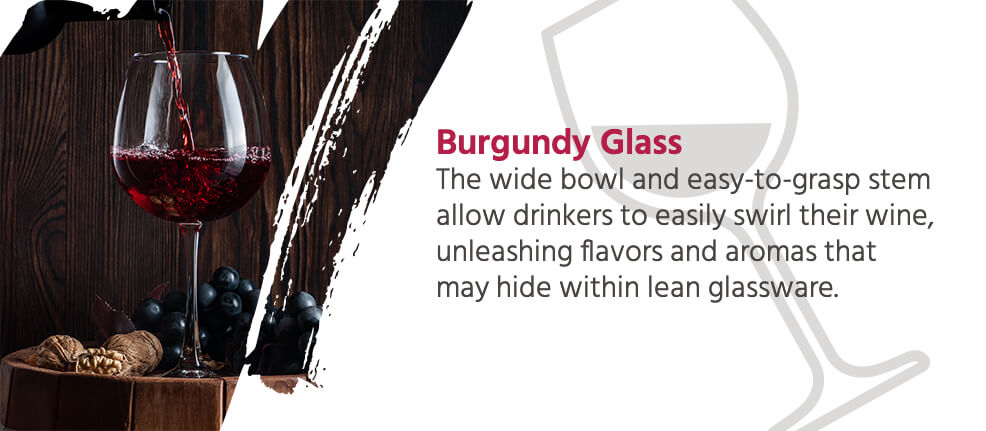
Burgundy glasses carry similar proportions to the Bordeaux glass, yet contain a wider bowl. This fuller bowl is Burgundy’s signature characteristic, as well as a slightly shorter glass stem. These dimensions make room for softer, more fragrant and delicate red wines to shine. The wide bowl and easy-to-grasp stem allow drinkers to easily swirl their wine, unleashing flavors and aromas that may hide within lean glassware. The bowl’s slope also means the wine will first hit the tip of your tongue before traveling to other areas, again leaving more room to highlight a wine’s more nuanced palates.
3. Cabernet Glass
Cabernet glasses are designed to focus and highlight the aromas of its wine. Wide, Burgundy-style bowls slope narrowly upward to create a small, tight rim without much room for natural air passage. Drinkers using a cabernet glass, therefore, experience a wine’s concentrated aromas first and foremost. The wide bowl still ensures proper aeration of its contents, with sips and smells funneled through the narrow mouth. Together, these features create a glassware type ideal for red wines with lots of sharp, bold tannins, which will soften in the breathable bowl, but still produce that signature mouth-drying sensation upon reaching the tongue.
4. Pinot Noir Glass
Pinot noir-style glasses are one of the most unique on this list. Among its key features are a wide, generous bowl and flared lips — in other words, a rim turned out slightly from the glass rather than smooth and straight. These flared rims often give away this style of wine glasses, and make them one of the most visually distinct in your collection.
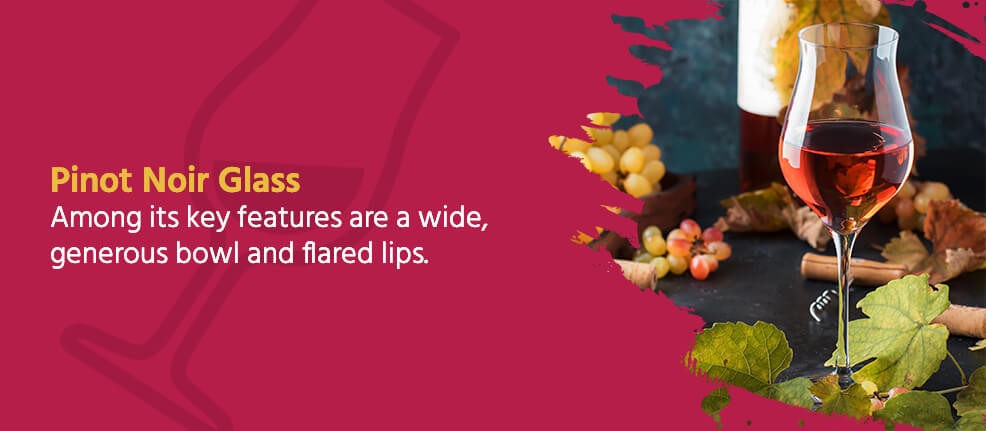
The wide bowl lets smoother reds gain the oxygen needed to amplify its subtler flavors, while the flared lips magnify its soft aromas and carry the wine to the middle of your mouth.
5. Zinfandel Glass
Red zinfandel wines are a light-bodied, highly acidic varietal, creating a lush, bright and fragrant flavor profile. As a result, zinfandel wine requires a glass that nurtures these aromas, while also moderating its typically high alcohol bite — Zinfandel can range up to 17% ABV!
Unlike many other red wines, zinfandel also doesn’t need aeration before serving. That means glassware with smaller, leaner bowls are perfect for this red varietal. Overall, aim for zinfandel glassware that’s slightly shorter than other red wine glasses, with a slim bowl and average-sized rim.
6. Shiraz Glass
Consider Shiraz glasses a cousin to the cabernet. Like its cab comrade, shiraz glassware contains a wide, oxygen-trapping bowl and a tapered, slim rim funneling the beverage to the middle of your mouth. Sips from a shiraz glass balance the sharp tannins innate to the varietal sharing its name, while pushing concentrated fruit notes forward. Together, these features provide a more complex and well-rounded drinking experience for this full-bodied, dense red wine type that can be overpowering — even astringent — when mistreated.
7. Port Glass
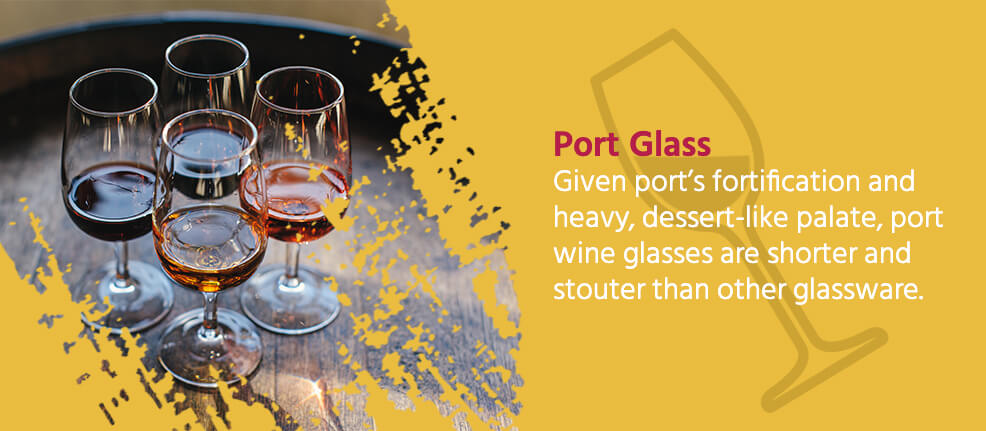
Port wine is a type of dessert wine containing additional alcohol, typically in the form of fortified spirits. It gets its name from its homeland of Portugal, where this sweet beverage is a popular post-dinner aperitif. Given port’s fortification and heavy, dessert-like palate, port wine glasses are shorter and stouter than other glassware. A proper port serving is three ounces, compared to the five- to six-ounce pours that are common for red and white wine. Glassware dedicated to port is a miniature version of the Bordeaux glass, with a smaller bowl proportionate to a small rim.
8. Sherry Glass
Sherry glasses are the smallest type on this wine glassware guide. Sherry glasses, designed specifically for the Spanish fortified wine carrying the same name, have a tiny, evenly proportioned bowl and a long stem, plus a small mouth. These glasses’ stems are so long that they’re the same size as the rest of the body. This length keeps drinkers’ hands out of the way as they sip, maintaining optimal temperatures for the sweet dessert wine held within.
9. Chardonnay Glass
You’ll often hear chardonnay glassware referred to as the “universal” white wine glass. Its all-purpose design runs similar to the pinot noir glass, meaning it centers on a wide bowl and a tapered, more concentrated rim. However, chardonnay glasses do not have flared lips, maintaining that classic U-shaped design resting on a medium-length stem. Chardonnay glasses will also be smaller in stature overall.
Chardonnay glassware is well-known for creating even, flavorful sips balancing earthy and fruity notes on the sides and tip of your tongue. It’s an excellent place to begin building your stemware collection, providing a versatile vehicle, particularly for dry white wines.
10. Riesling Glass
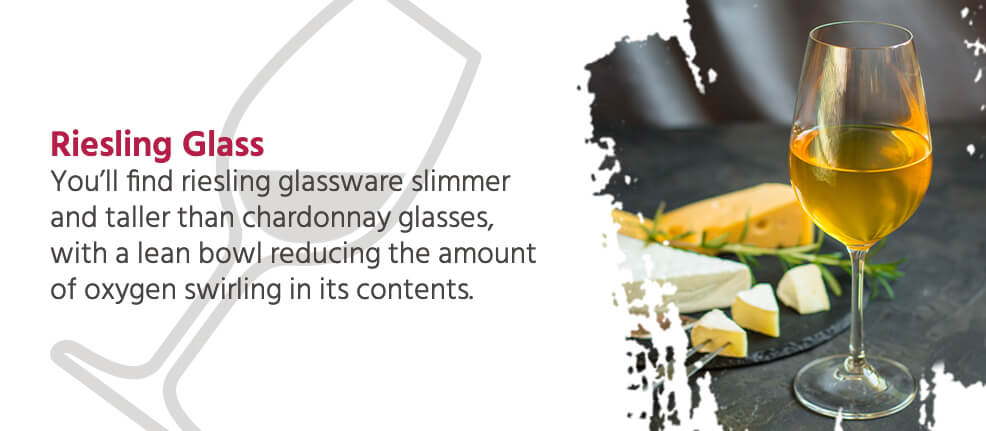
Riesling wine receives accolades for its acidic, perfumed qualities, presenting a particularly aromatic white wine. Its namesake glass comes designed to enhance those very characteristics. You’ll find riesling glassware slimmer and taller than chardonnay glasses, with a lean bowl reducing the amount of oxygen swirling in its contents. Too much aeration can detract from riesling’s naturally floral bouquet. The best-designed riesling glassware pushes sips to the back of your mouth, where they won’t overpower your taste buds with fruit-forward sweetness.
11. Sauvignon Blanc Glass
Sauvignon blanc glasses are tall and narrow, with a slightly leaner bowl concentrating a white wine’s fruity flavors. The slim bowl runs proportionate to its topmost rim, which slants delicately inward to funnel fruit flavors and aromas to the nose and front of the mouth.
Originally designed to enhance the vibrant lime, nectarine, kiwi and passion fruit flavors in its namesake sauvignon blanc wine, this glass type also helps preserve many varietals’ natural acidity and minerality. Indeed, the glass’ shape moves wine immediately to the front and top of the mouth, which keeps acidity sharp and uplifting, rather than muddling it in the less sensitive rear of the tongue.
12. Rose Glass
Rose glasses — pronounced like the flower, not the wine type — come in two forms: flared and unflared. Flared lips curve outward along the rim, compared to unflared, which maintains the classic U-shaped glass design. Both flared and unflared rose glasses come with short, stout bowls and a long stem, shielding contents from your hand’s natural warmth.
Select a flared rose glass when drinking a younger or unoaked wine. Young wines, in particular, tend to have a less developed sweetness to them. Drinking from flared edges directs wine straight to the more sensitive parts along the edges and tip of your tongue, increasing the delivery of complex flavors.
13. Saucer
Also known as the coupe or vintage glass, saucers are one of the oldest styles of glassware still available today. Sipping drinks in a saucer sends immediate flashbacks to the Roaring ’20s, when this beverage vehicle first came into prominence. Think a shallow, circular bowl leading to a flat, low and generously sized rim keeping contents well aerated.
Many chastise coupes and saucer-style glassware for providing style, but no substance. Their signature wide rims and shallow bowls may over-aerate, dissipating a beverage’s natural bubbles and bouquets.
14. Flute
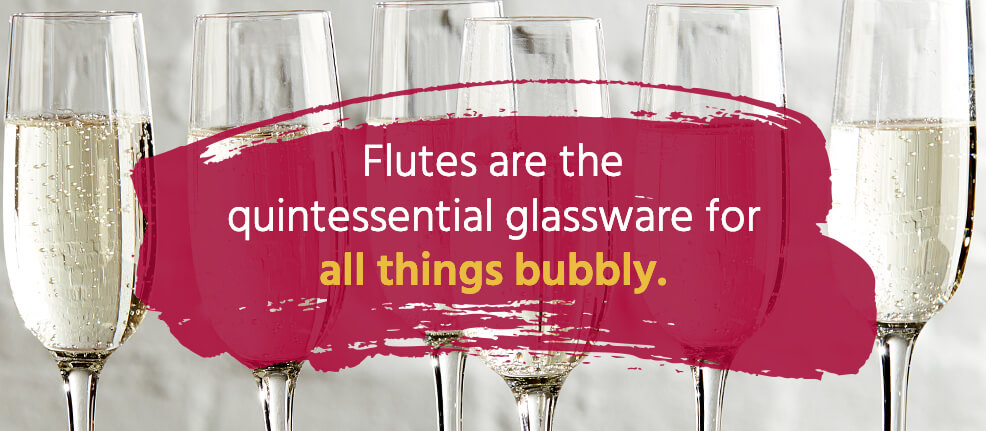
Flutes are the quintessential glassware for all things bubbly. These slim, narrow glasses hold contents in a lean bowl, eschewing the traditional U-shaped design for a tall, slender glass with an equally long stem. The upright build retains carbonation better than any other glassware and is why flutes are the best choice for drinking fizzy champagne.
The slender flute also works like a charm for transferring delicate flavors straight to the tip of your tongue. It will enhance even young bottles of bubbly, though can mute more mature wines.
15. Tulip
Tulip glasses embody many of the same traits as a flute, namely the tall stem and slender body. However, whereas flutes stand upright and linear, the tulip glasses contain a bulged bowl that narrows once again before reaching the rim. This design creates its signature tulip profile, mirroring the popular flower.
The glass’s curved shape still encourages carbonation to rise to the mouth continually. However, the wider bowl provides more oxygen, coaxing added nuanced flavors and aromas from its contents. For this reason, tulip-style glasses are best for aged or more mature “vintage” champagne bottles.
16. Stemless
As its name suggests, stemless glasses remove the long-handled stem of traditional wine glasses. Instead, drinkers hold their glassware around its bowl. It’s a versatile and aesthetic choice for red, white and rosé wine, though not ideal for sparkling.
Many enjoy stemless glasses for their contemporary appearance. This style of wine glass is also easier to wash, as well as less prone to spills or tipping over. However, cons to stemless glasses are a natural byproduct of its design: Drinkers steadily transfer heat every time they clutch their glass, potentially altering the taste of their drink.
17. Decanter
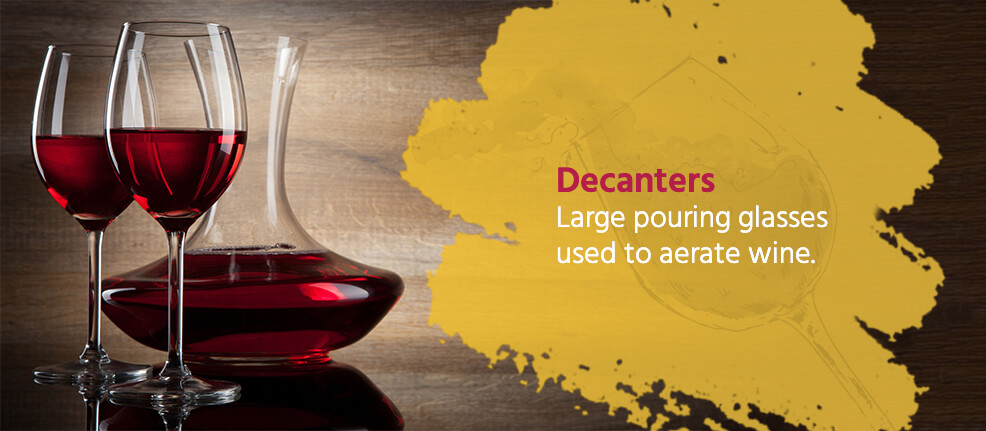
Decanters are large pouring glasses used to aerate wine. Traditionally, you would open a bottle of wine and immediately pour it into a decanter. The decanter’s broad, roomy bowl then serves to allow steady streams of oxygen to open up and soften robust, tannin-heavy wines, enriching their final flavor.
- Ideal for: Cabernet sauvignon, Chianti, syrah, petite syrah, Barolo, Nebbiolo
Not all varietals require a decanter. You can detract from the taste of some red and white wine types alike if you aerate them in a secondary glass. Think mellow, lighter-bodied reds like Beaujolais, pinot noir, red zinfandel, Dolcetto and red Burgundy, as well as any white wine served chilled. None of these require pouring into a decanter.
Which Wine Glass for Which Type of Wine?
When considering wine glass shapes and uses, generally speaking, serving red wine calls for larger glassware with wider bowls and narrow, tapered rims. Conversely, white wines and rosés tend to do best in U-shaped glasses with proportionately slim bowls and rims.
Rather than worrying about owning a different type of glass for every wine varietal, though, consider stocking different shaped glasses for each of the four major wine types. And hey, if you don’t enjoy one of the four types, you have even less to worry about!
- Wine glasses for red wine: Aim for glassware with taller stems, generous bowls and a slight-to-medium inward taper at the rim. That inward slant prevents red wine’s stronger tannins from assailing your nose with every sip.
- Wine glasses for white and rosé wine: Opt for glassware that is smaller, lighter, upright and traditionally U-shaped, preventing too much aeration from dulling any delicate flavors.
- Wine glasses for sparkling wine: Select tall, slender and straight stemware like flutes and tulips for bubbly-ready special occasions.
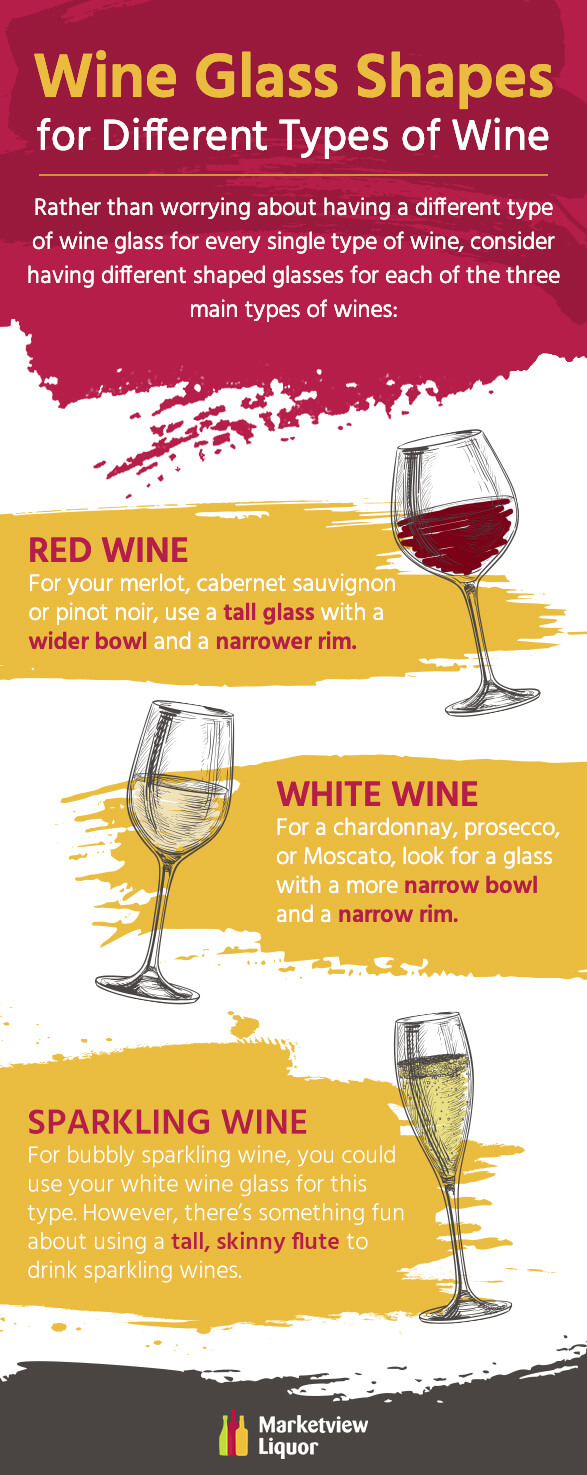
Keep reading for the exact proper wine glass pairings for your favorite types of wine — then, finally, invite that special someone over you’ve been meaning to impress.
Types of Glasses for Red Wine
There are hundreds of red wine grape varietals cultivated around the world. That figure doesn’t account for the specialty mixtures crafted by winemakers looking to coax new, exciting red wine blends melding complementary varietal textures, aromas and flavors.
Given the sheer number of red wine grapes grown today, it can be confusing to pair specific varietals with an ideal glass. Explore the specific wine glassware listed below to see how you should serve your favorite type of red wine.
1. Cabernet
A cabernet glass’ large bowl and narrow rim is the ideal portal allowing big, bold red wine to be its best self.
With this design, a wine’s natural fragrances accumulate at the top of the glass. Every time someone goes to take a drink from their glassware, they get an expressive burst of primary and secondary aromas alongside wine correctly aerated in the large bowl. The result allows full-bodied, high-tannin wines to be lush, robust and complex without going overboard.
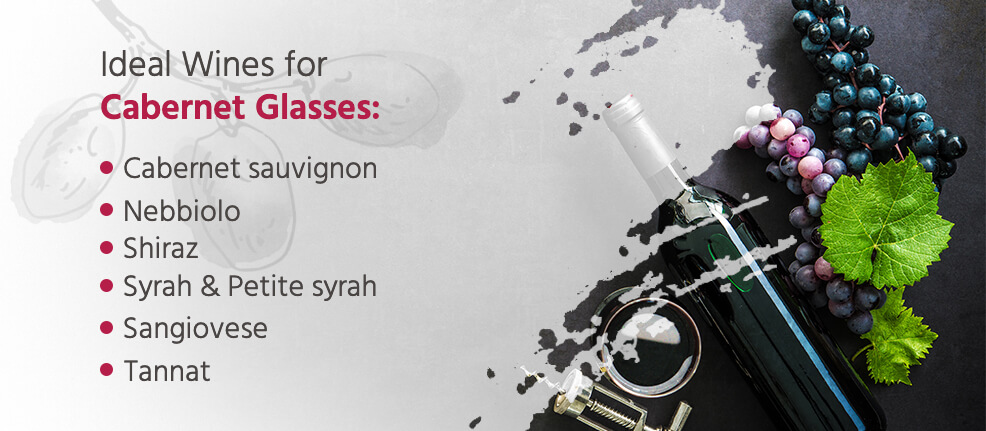
- Ideal wines for cabernet glasses: Cabernet sauvignon, Nebbiolo, Shiraz, syrah, petite syrah, Sangiovese, Tannat
2. Burgundy
Select Burgundy glasses for smoother, silkier red wines or wines with more delicate flavor profiles. The glassware’s generous bowl but narrow, tapered lip accumulates as much of the glass’ bouquet as possible, amplifying every taste. Meanwhile, Burgundy’s thin lips maintain the velvet mouthfeels innate to a handful of red wine varietals that you don’t want to muddle using other vehicles.
- Ideal wines for Burgundy glasses: Red Burgundy, Pinot Noir, Barbaresco, Dolcetto, grenache, Barbera, Valpolicella blends
3. Bordeaux
If you haven’t caught on yet, many types of wine glasses pair exceptionally well with their namesake varietal. And this is not a coincidence. As winemakers over the decades have better understood the unique chemical compositions making up wine grape varietals, they’ve designed glasses to exclusively — and exceptionally — optimize their grapes.
Bordeaux glassware is no exception. One of the proverbial homes of dozens of red and white wine varietals, Bordeaux, France, has made an art out of wine drinking. Bordeaux wine glass designs reflect that treasured history, offering the tallest glass on the list, a signature large bowl and slightly narrowed lip perfect for a range of medium and full-bodied reds.
- Ideal wines for Bordeaux glassware: French Bordeaux red blends, malbec, cabernet sauvignon, petite syrah, Mourvedre, Nero D’Avola, Shiraz, cabernet franc
4. Pinot Noir
Pinot noir glasses are quite similar to Burgundy glassware. Indeed, the two are almost interchangeable when it comes to serving a handful of lighter-bodied red wines, including pinot noir itself.
However, the pinot noir wine glass deserves a place at the table when introducing red wines to new drinkers, especially for someone leery of red wine being too harsh or astringent. Selecting a glass that will enhance the lightness and silkiness of their drink, exactly like pinot noir glassware, can transform their preconceived expectations.
- Ideal wines for pinot noir wine glasses: Pinot noir, Gamay, Beaujolais, Zweigelt
5. Shiraz
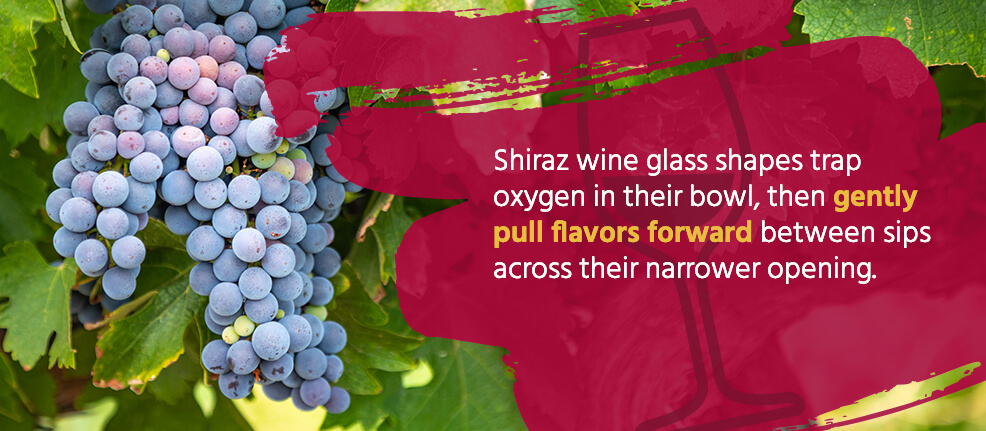
Shiraz glassware has a similar shape to cabernet glasses. Both these wine glass types seek to soften and balance the heavy and tannin-forward wines sharing their names. As such, Shiraz wine glass shapes trap oxygen in their wide bowl, then gently pull flavors forward between sips across their narrower opening.
- Ideal wines for Shiraz glassware: Shiraz, syrah, petite syrah
6. Zinfandel
Bright, zippy and tart, red zinfandel is a unique varietal requiring an equally unique glass shape. Its equally proportioned, medium-sized glass means sips coat the tongue evenly and contributes a vibrant overall flavor, exactly what you’re looking for in a quality red zinfandel. Pour into this type of wine glass immediately after opening a new bottle, no decanting required.
- Ideal wines for zinfandel glassware: Red zinfandel
7. Port
Serve fermented wines like port in smaller, three-ounce portions inside glasses shaped to minimize strong, harsh alcohol scents. Port glasses, in particular, offer a tight, narrow mouth with thicker lips to encourage savoring the beverage while discerning concentrated aromas, but still a large enough bowl to gently swirl your contents.
- Ideal wines for port glasses: Any port wine, including white, ruby, tawny and rosé
The Right Glasses for White Wine and Rosé
Just like specific red wines pair best with particular glasses, consider matching your favorite white wines and rosés to the stemware below.
1. Chardonnay
With their classic U-shaped bowl and tapered, thin lips, chardonnay glasses are ideal for full-bodied white wines. This shape glides sips easily from the tip through the back of the mouth, ensuring you pick up on every sweet, acidic and mineral note in your white wine.
- Ideal wines for chardonnay glasses: Oaked and unoaked chardonnay, pinot grigio, Semillon, pinot blanc, White Burgundy, Chenin blanc, Viognier
2. Riesling
Riesling wine glassware is small and lean, featuring a narrower rim keeping wine away from the tip of your tongue, where its namesake varietal would bombard sweet sensors. Choose this more delicate glass type when drinking bright, fruity and refreshingly acidic wines like any of the following.
- Ideal wines for riesling glassware: Riesling, white zinfandel, Gewurztraminer, Chenin blanc, Gruner Veltliner, Albariño
3. Sauvignon Blanc
Sauvignon blanc continues to be one of the most popular white wine varietals in the world. Its namesake glass runs slightly taller than most other white wine glasses, with a slender bowl and lean lips concentrating all the earthy, mineral and fruit notes famous in sauvignon blanc. It’s an excellent selection when drinking more delicate or complexly layered white wines, since its shape comes designed explicitly to present a full palate with every drink.
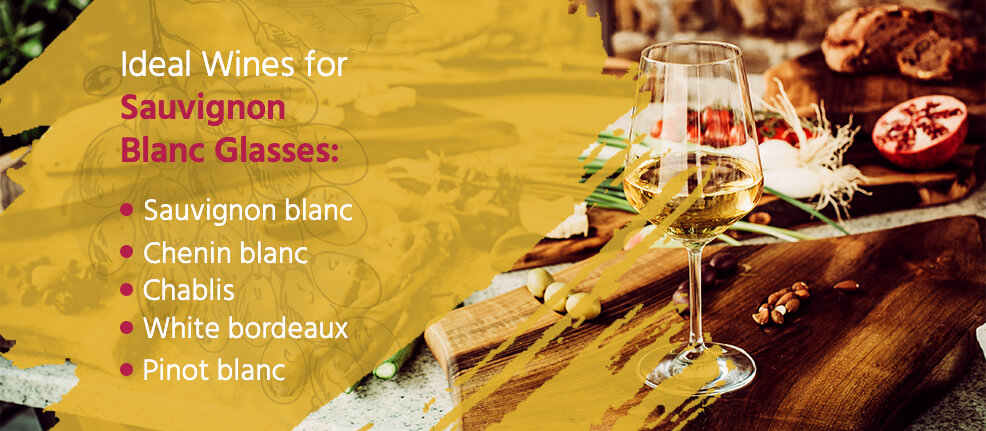
- Ideal wines for sauvignon blanc glasses: Sauvignon blanc, Chenin blanc, Chablis, White Bordeaux, pinot blanc
4. Rose
Rose-shaped glasses, with their delicately flared lips, add texture and tang when drinking a range of red, white or rosé wine. These are versatile pieces best used on younger, unoaked wines to experience their full, bright sweetness.
- Ideal wines for rose-shaped glassware: Rosés, young pinot grigio, Moscato d’Asti and Gewürztraminer
Types of Glasses for Sparkling Wine
Sparkling wine’s carbonation requires a specially designed glass that will preserve and encourage its innate fizziness. For that, there’s no better glassware than flutes and tulips — though don’t count the elegant coupe out of the race just yet.
1. Flute
Flute glassware makes any occasion feel immediately sophisticated. From brunch with friends to graduation parties to a night in sharing a bottle with a special someone, use flutes to preserve sparkling wines’ carbonation. Maintaining your beverage’s natural bubbles also ensures its flavors remain lively and crisp. After all, what fun is flat bubbly?
- Ideal wines for flutes: Young non-vintage champagne, Prosecco, Cava, sparkling white wine
2. Tulip
Tulip glasses are often rounder, yet slimmer, than flutes, owing to their resemblance to the tulip flower bud. It’s a unique and elegant design ideal for mature, or “vintage,” champagne and higher-end sparkling varietals.
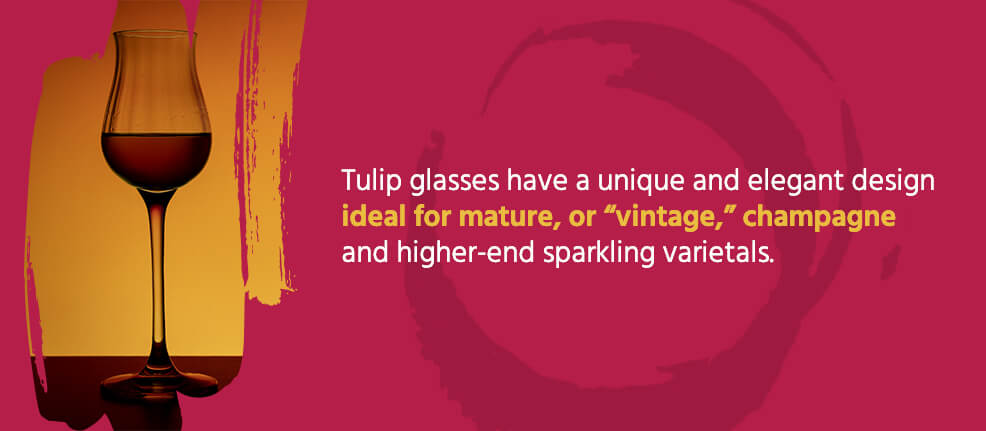
The tulip glass’ small, rounded bulge traps just enough oxygen for richer sparkling wines to unleash full profiles. At the same time, the slender lips direct sips immediately to the tip of the tongue for drinkers to capture a wine’s nuances and complexities.
- Ideal wines for tulip glassware: Vintage champagne (Premier Cru and Grand Cru), Franciacorta, Asti (sparkling Italian wine from Piedmont)
3. Saucer/Coupe
Coupes have largely fallen out of favor for events where sparkling wines and vintage champagne are the stars of the drink menu. Their wide, shallow bowls tend to invite too much oxygen to mix with the contents, delineating a sparkling wine’s crisp aromas and reducing its bubbles. As a result, sparkling wine can quickly fall flat.
However, its aesthetics and history do make this glassware appealing for some themed parties. What’s more, coupe/saucer-style wine glasses can be a fitting design for sparkling-wine based as well as classic cocktails. Their wide base is a benefit, not a drawback, harmonizing all the flavors of a mixed drink and allowing sips to coat a larger portion of the mouth.
- Ideal drinks for saucer/coupe glassware: Themed cocktails, some Prosecco and Cava
Other Types of Wine Glass Uses and Purposes
For specialty wines or memorable occasions, consider bringing out these different pieces of glassware for the best possible wine-tasting experience.
- Sherry glass: Sherry wine’s fortification makes it hold a dense, even syrupy mouthfeel. Like red and white wines, there are many types of sherries ranging in flavors, bodies, aromas and ABVs, giving you a world of options to explore. Plus, with sherry seeing a resurgence due to waves of sherry-touting famous mixologists, you’ll score style points presenting this spirit at your next party or get-together. Use the small and triangular sherry glass for serving any sweet, dry and off-dry sherries, as well as cordials and similar dessert spirits.
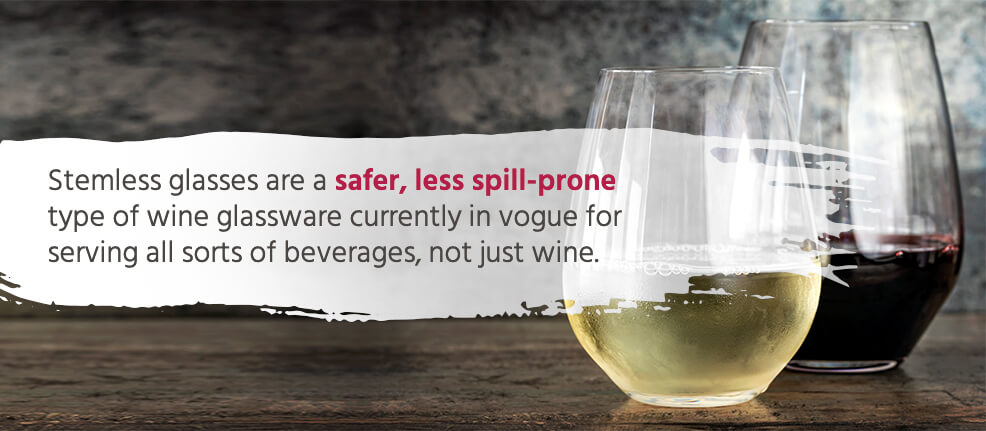
- Stemless: Stemless glasses are a safer, less spill-prone type of wine glassware currently in vogue for serving all sorts of beverages, not just wine. Their simple U-shaped profile and average rim size give it a Goldilocks appeal for medium-bodied, sweet and savory-leaning wines. Just watch out for over-warming your glass with your hand. Stemless wine glasses are ideal for drinking varietals like pinot grigio, sauvignon blanc, merlot, Sangiovese, Negroamaro and cabernet franc.
- Balloon glass: Balloon glassware emphasizes a rounded, generously sized bowl atop a tall stem for the express purpose of swirling tannin-heavy wines. The width and depth of the bowl aerate bold reds and heavier, oakier whites such as Semillon and oaked chardonnay, while its large mouth emits fragrant bouquets for the drinker to take in with their sips. Balloon glasses’ tall stems and wide bowls additionally preserve a wine’s serving temperature. Consider purchasing balloon glassware when you regularly find yourself trying different full-bodied, heavy and oaky wines. Its size and scale make it adaptive to varietals with these characteristics without pigeonholing you into a more specific red or white glass set.
Additional Considerations About Various Wine Glasses
Investing in the right glassware to amplify the flavors of your favorite wines is essential. There are other details to consider when stocking your bar cart with wine ware, as well — details that save you time, space and money.
- Storage space: Let’s be honest. It’s unreasonable to possess all types of wine glasses specially shaped to enhance every varietal. You’d need an entire wall of cabinets dedicated exclusively to your collection! Instead, pick two to three glass types made to complement the experience of enjoying your favorite wines. If wine is a casual, rather than go-to, drink in your home, opt for the most versatile glass shapes — one for red and one for white.
- Glass versus crystal: The majority of wine glasses are either glass or crystal. While cost or aesthetic preference will guide which of these materials you prefer, it’s also worth noting you must carefully hand-wash fine crystal. Comparatively, most glass stemware can go in the top rack of home dishwashers. Always check the manufacturer’s or maker’s recommendations to be safe.
- Budget: Bargain hunters can shop for stemware sets containing a few types of versatile wine glasses — typically one type for red, one type for white and one for sparkling. When budget is your biggest concern, stick with these pre-packaged sets meant for a broad range of wines, rather than spiraling into the nitty-gritty. Over time, you can add more exact pieces.
Different Types of Wine Glasses
From full-bodied reds to light and fruity whites, a wide number of wines brings the need for many different types of glasses. Whether you’re an experienced wine drinker or a casual sipper, choosing the right glass can take your tasting experience to the next level.
Parts of a Wine Glass
At the most basic level, there are two types of wine glasses — stemmed and stemless. A stemmed wine glass comprises a base, stem and bowl.
Stemless glasses differ in their wine glass aesthetic and do not feature a base or stem. Instead, these glasses have a bowl with a flat bottom to sit evenly on a table.
While parts will vary between glasses, the bowl’s shape and style are most important for the type of wine you want to enjoy.
Red Wine Glasses
Glassware for red wine is generally oversized in height and has a more significant bowl size than white wine to allow more oxygen to come into contact with the drink. Some examples of red wine glasses include:
- Bordeaux glasses
- Cabernet glasses
- Shiraz glasses
- Burgundy glasses
- Pinot Noir glasses
- Zinfandel glasses
White Wine Glasses
White wine is best served in glasses that are smaller in height and bowl size than red wine glasses. This smaller size enables the wine to be closer to your nose so you can detect the lighter aromas. Some white wine glasses include:
- Sauvignon Blanc glasses
- Riesling glasses
- Chardonnay glasses
Sparkling Wine Glasses
Glasses for champagne and sparkling wines are typically smaller and narrower in shape to help preserve carbonation and flavor. A slim wine glass shape also aids in directing carbonation to your tongue instead of your nose. Sparkling wine glasses include flute, saucer and tulip-shaped glasses.
Rosè Wine Glasses
When it comes to glasses for rosè and blush wine, you can choose between flared and tapered rims. Flared-rimmed glasses can enhance the sweetness of young rosè, while tapered-rimmed glasses work well with mature rosè.
Dessert Wine Glasses
Dessert wines are typically super-sweet and highly concentrated, requiring a short and unique design that directs your drink to specific taste buds. A dessert wine glass aims to encourage drinkers to savor their wine and immerse themselves in the flavors. Dessert wine glasses are typically available in a port or sherry glass option.
Universal Glasses
If you have limited options for drinkware, universal or all-purpose glasses are great for enjoying the best features of red and white wine. Universal glasses can be stemmed or stemless and provide similar tasting experiences.
Find the Perfect Bottle of Wine for Your Glass at Marketview Liquor
Pair your favorite glass with a delicious bottle of wine from Marketview Liquor. We offer a wide selection of reds, whites and every shade of blush in between. Buy online by the case or bottle today!

Get Your Favorite Wines
Ready to put your new knowledge about different wine glass shapes to the test? Marketview Liquor has a wide selection of wines you can browse online and have shipped right to your door. Don’t forget to bring your new glassware! Take our Wine Pairing Quiz to pair your wine perfectly for your next occasion.

